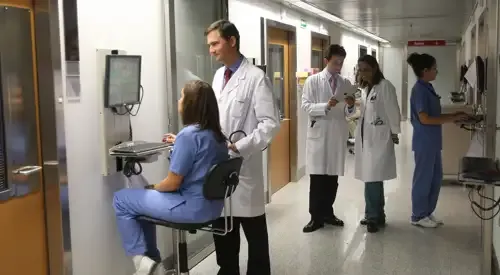Anal fissure
"The first step to be taken with a patient presenting this pathology is to avoid constipation through a diet rich in fiber".
DR. JORGE BAIXAULI
SPECIALIST. GENERAL AND DIGESTIVE SURGERY DEPARTMENT

The anal fissure can be defined as an ulcer located in the final part of the anal canal, of frequent appearance and that causes great discomfort in the form of intense pain in spite of its small size.
The typical location of these ulcers is in the anterior and posterior anal margin.
Apparently, the pain produced by the formation of this ulcer triggers a reflex contraction of the anal musculature, which prevents a correct healing of the fissure and a perpetuation of this disease.
For this reason, the treatments applied are aimed at overcoming this muscle contraction or hypertonia.

What are the symptoms of anal fissure?
The typical symptom of anal fissure is the appearance of very intense, sharp and cutting pain, clearly associated with the passage of stool during deposition and that persists for a variable time after this (from minutes to hours).
The presence of light red blood is possible, although normally scarce, especially with cleansing after the bowel movement. In addition, sometimes it is also associated with the presence of itching or stinging in the anus.
The most common symptoms are:
- Intense pain.
- Constipation.
- Bleeding.
Do you have any of these symptoms?
You may have an anal fissure
What are the causes of anal fissure?
The initial formation of these ulcers can be due to multiple causes, the most important being the association with chronic constipation.
Any reason that may predispose or dispose the anal mucosa to trauma (passage of very solid stools, very liquid and irritating diarrhea, chemotherapy treatments, other previous anal disorders such as hemorrhoids, etc.) may influence the appearance of an anal fissure.
How to prevent it?
The first step to take is to avoid constipation by eating a diet rich in fiber or taking what are known as bulking agents (compounds of seeds that promote soft, non-diarrheal stools and are substitutes for vegetable fiber).
How is anal fissure diagnosed?

The diagnosis of anal fissure is based on the symptoms referred by the patient and the observation of the ulcer in the described position.
In the event of an anal ulcer in an abnormal location or with atypical symptoms, it is recommended that tests be performed to rule out other possible causes mentioned above: colonoscopy to rule out inflammatory bowel disease, microbiological culture of the lesion or biopsy if necessary.
How is anal fissure treated?
It is recommended to perform sitz baths with warm water for 10-15 minutes after each bowel movement.
The application of topical treatments based on ointments or creams containing local anesthetics, anti-inflammatory (corticoids etc.) may produce symptomatic relief.
Recently, the treatment of the anal fissure has been established with ointments or ointments based on nitroglycerin, whose action is based on the production of a relaxation of the sphincter muscles, so that, when applying it during at least one month, the healing of the ulcer would be allowed.
Based on the same foundation, there is the injection of botulinum toxin into the sphincter muscle that would produce a reversible paralysis of the sphincter muscle, with the consequent beneficial effect on the healing process of the ulcer.
When all the described treatments fail, surgical treatment is indicated. This intervention consists of the section of approximately 1cm of the internal sphincter muscle, after checking the existence of hypertonia of this one.
The results of this intervention are excellent and the improvement in the symptomatology is practically immediate, although its irreversible character advises the first realization of other more conservative treatments.
Where do we treat it?
IN NAVARRE AND MADRID
The Department of General Surgery
of the Clínica Universidad de Navarra
The Department of General and Digestive Surgery is made up of specialists dedicated to the surgical treatment of endocrine, breast, gastrointestinal, hepatobiliary, pancreatic, colorectal and abdominal wall diseases, with special dedication to oncological surgery.
The application of laparoscopic surgery in the interventions reduces the hospital stay, the post-operative discomfort and shortens the patient's recovery.
We have a great experience in laparoscopic colorectal surgery, of the adrenal gland, liver and pancreas, as well as in obesity surgery.
Treatments we perform
- Colorectal surgery.
- Breast surgery.
- Surgery of the hemorrhoids.
- Pelvic floor surgery.
- Endocrine and obesity surgery.
- Esophageal and gastrointestinal surgery.
- Hepatobiliary and pancreatic surgery.
- Abdominal wall surgery.
- Liver transplant.

Why at the Clinica?
- Center of Excellence in Obesity Surgery by the International Federation for Bariatric Surgery.
- 90% survival rate in liver transplants.
- We are the private hospital with the largest technological equipment.

















